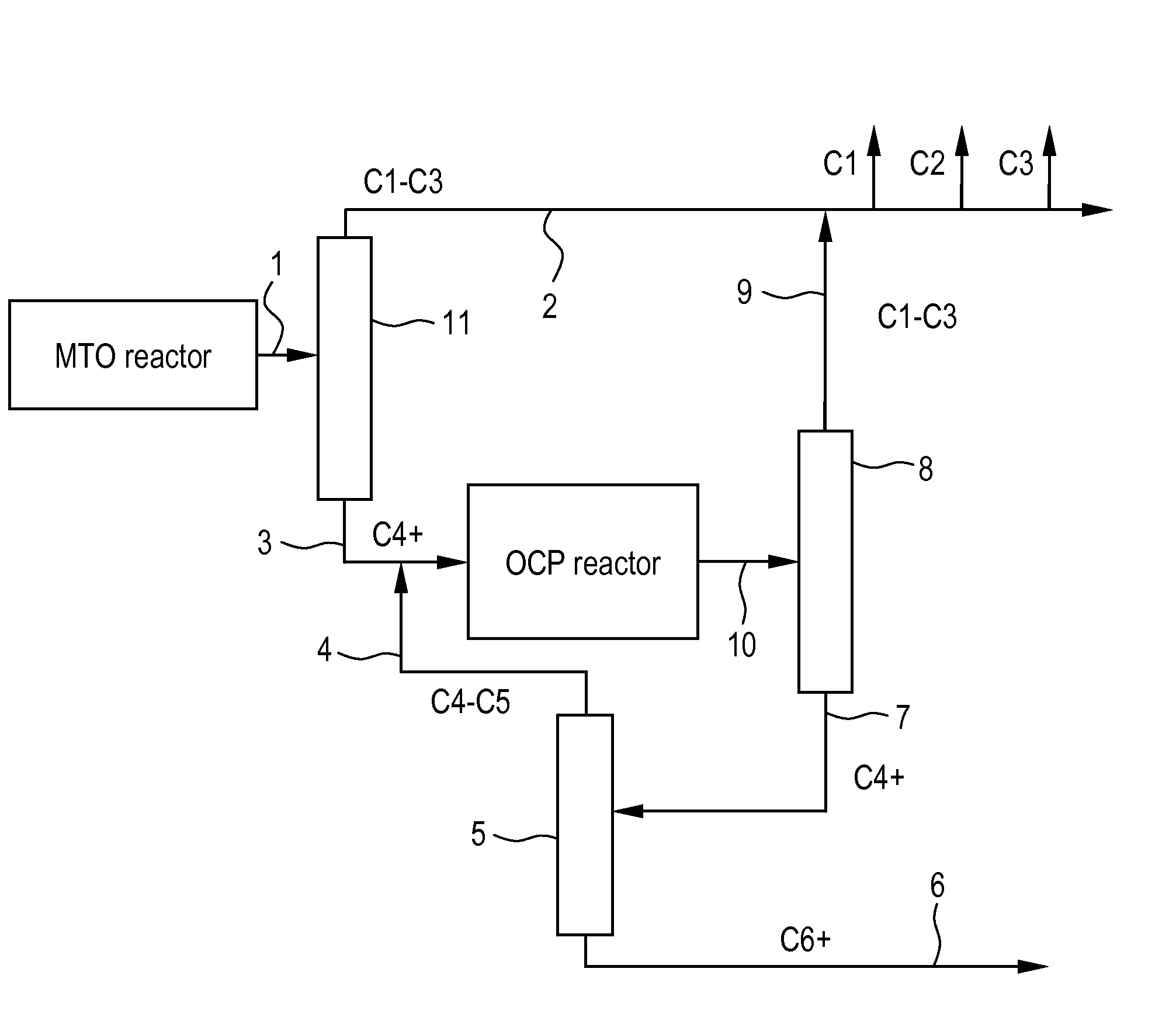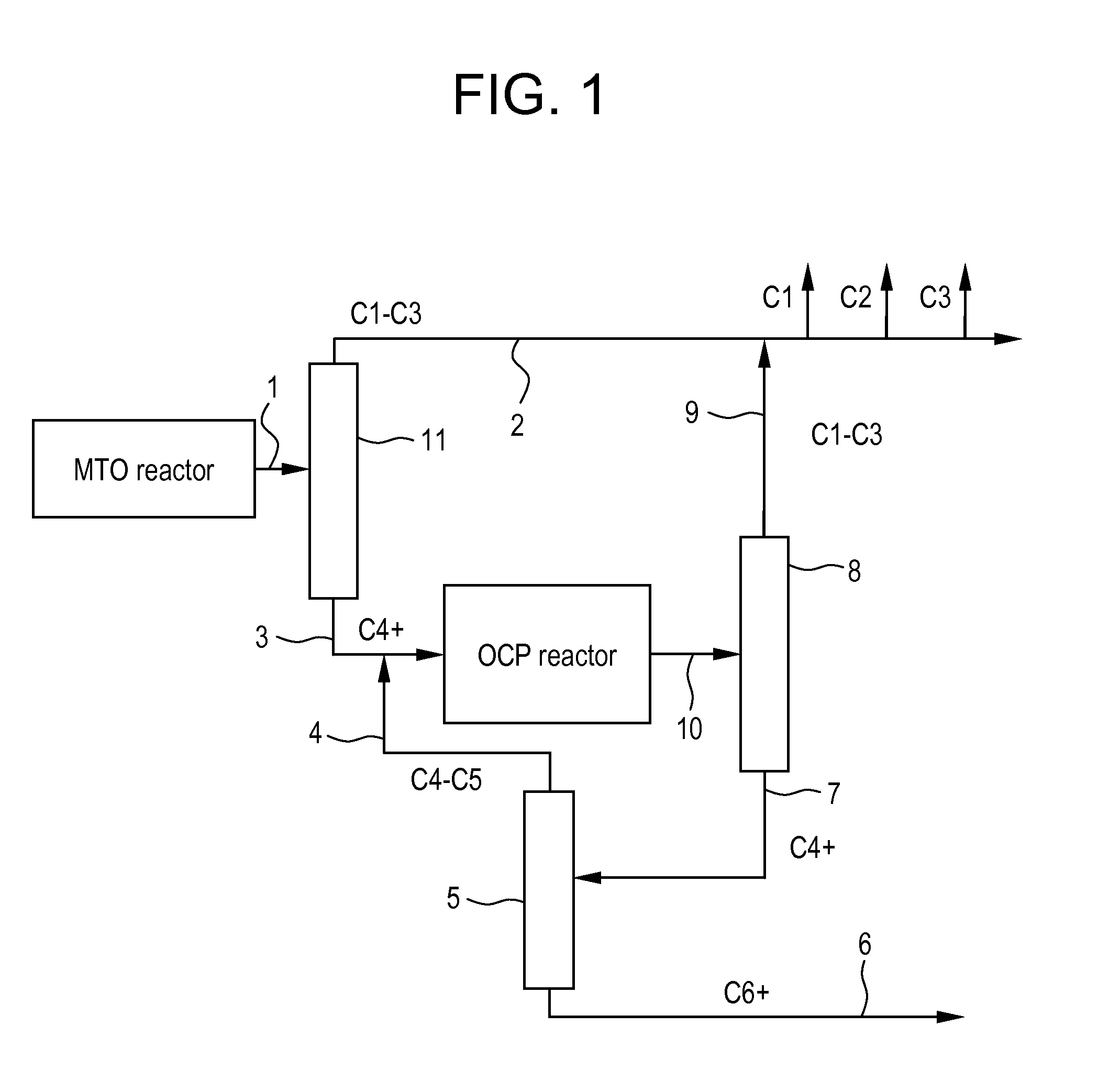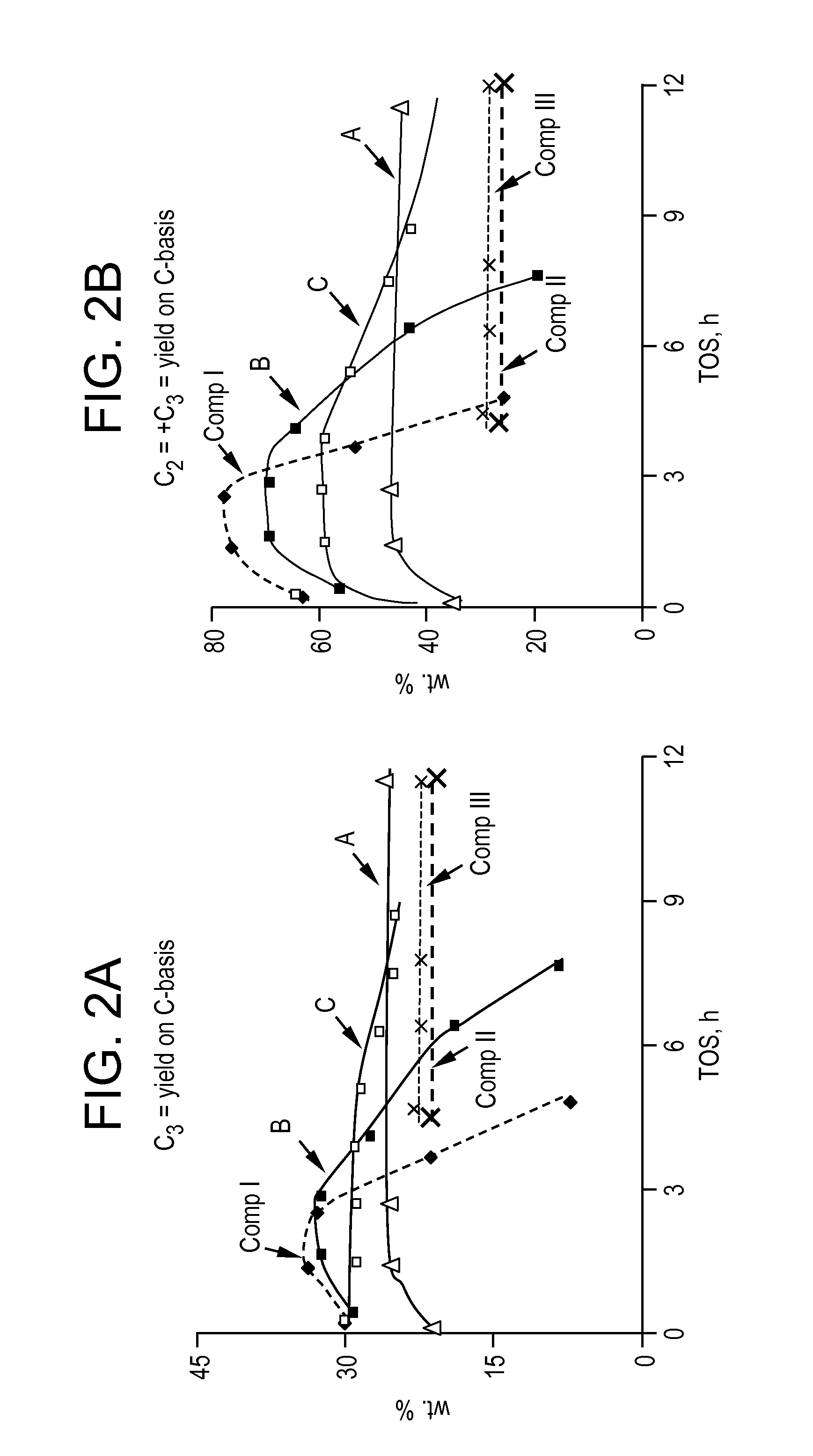[0038]According to another embodiment of the invention said olefin products (the
effluent of the XTO) are fractionated to form a
stream comprising essentially
ethylene and at least a part of said
stream is recycled in the XTO reactor to increase the propylene production and then the flexibility of
ethylene vs propylene production.
[0044]The MFI or MEL catalyst having a high
silicon / aluminum
atomic ratio may be manufactured by removing aluminum from a commercially available crystalline
silicate. A typical commercially available silicalite has a
silicon / aluminum
atomic ratio of around 120 to 300. The commercially available MFI crystalline silicate may be modified by a
steaming process which reduces the tetrahedral aluminum in the crystalline silicate framework and converts the aluminum atoms into octahedral aluminum in the form of amorphous
alumina. Although in the
steaming step aluminum atoms are chemically removed from the crystalline silicate framework structure to form
alumina particles, those particles cause
partial obstruction of the pores or channels in the framework. Accordingly, following the
steaming step, the crystalline silicate is subjected to an extraction step wherein amorphous
alumina is removed from the pores and the micropore volume is, at least partially, recovered. The physical removal, by a leaching step, of the amorphous alumina from the pores by the formation of a water-soluble
aluminum complex yields the overall effect of de-alumination of the MFI crystalline silicate. In this way by removing aluminum from the MFI crystalline silicate framework and then removing alumina formed therefrom from the pores, the process aims at achieving a substantially homogeneous de-alumination throughout the whole pore surfaces of the catalyst. This reduces the acidity of the catalyst and thereby reduces the occurrence of
hydrogen transfer reactions in the
cracking process. The framework
silicon / aluminum ratio may be increased by this process to a value of at least about 180, preferably from about 180 to 1000, more preferably at least 200, yet more preferably at least 300 and most preferably around 480.
[0092]As regards the mixture of (A) and MeAPO, it can be made by co-synthesis procedure (synthesis of MeAPO-(A) composites materials) optionally followed by formulation into a catalyst. The mixture of (A) and MeAPO can be used as itself as a catalyst. In another embodiment it can be formulated into a catalyst by combining with other materials that provide additional
hardness or catalytic activity to the finished catalyst product. Materials which can be blended with the mixture of (A) and MeAPO can be various
inert or catalytically active materials, or various binder materials. These materials include compositions such as kaolin and other clays, various forms of
rare earth metals, alumina or alumina
sol, titania, zirconia,
quartz, silica or silica
sol, and mixtures thereof. These components are effective in densifying the catalyst and increasing the strength of the formulated catalyst. The catalyst may be formulated into
pellets, spheres, extruded into other shapes, or formed into a spray-dried
powder. The amount of mixture of (A) and MeAPO which is contained in the final catalyst product ranges from 10 to 90 weight percent of the total catalyst, preferably 20 to 70 weight percent of the total catalyst.
[0111]In mixing the catalyst with a binder, the catalyst may be formulated into
pellets, spheres, extruded into other shapes, or formed into a spray-dried
powder. In the catalytic
cracking process of the OCP reactor, the
process conditions are selected in order to provide
high selectivity towards propylene or
ethylene, as desired, a stable olefin conversion over time, and a stable olefinic
product distribution in the effluent. Such objectives are favored by the use of a low acid density in the catalyst (i.e. a high Si / Al
atomic ratio) in conjunction with a low pressure, a high
inlet temperature and a short
contact time, all of which process parameters are interrelated and provide an overall
cumulative effect. The
process conditions are selected to disfavour
hydrogen transfer reactions leading to the formation of paraffins, aromatics and
coke precursors. The process operating conditions thus employ a high
space velocity, a low pressure and a high
reaction temperature. The LHSV ranges from 5 to 30 hr−1, preferably from 10 to 30 hr−1. The olefin
partial pressure ranges from 0.1 to 2 bars, preferably from 0.5 to 1.5 bars (absolute pressures referred to herein). A particularly preferred olefin
partial pressure is
atmospheric pressure (i.e. 1 bar). The heavy hydrocarbon fraction feedstock is preferably fed at a total
inlet pressure sufficient to convey the feedstocks through the reactor. Said feedstock may be fed undiluted or diluted in an
inert gas, e.g.
nitrogen or steam. Preferably, the total absolute pressure in the second reactor ranges from 0.5 to 10 bars. The use of a low olefin
partial pressure, for example
atmospheric pressure, tends to lower the incidence of
hydrogen transfer reactions in the cracking process, which in turn reduces the potential for coke formation which tends to reduce catalyst stability. The cracking of the olefins is preferably performed at an
inlet temperature of the feedstock of from 400° to 650° C., more preferably from 450° to 600° C., yet more preferably from 540° C. to 590° C., typically around 560° to 585° C.
[0114]The various preferred catalysts of the OCP reactor have been found to exhibit high stability, in particular being capable of giving a stable propylene yield over several days, e.g. up to ten days. This enables the olefin cracking process to be performed continuously in two parallel “swing” reactors wherein when one reactor is operating, the other reactor is undergoing
catalyst regeneration. The catalyst can be regenerated several times.
[0119]The performance of the catalyst of the present invention is substantially better that the simple sum of individual component. This shows a
synergy of two molecular sieves in XTO and very particular catalytic properties. The catalyst shows good behaviour in XTO process in terms of stability and C3 / C2 ratio, propylene purity and heavy olefins production (higher C4+ olefin yield for recycling).
 Login to View More
Login to View More 


